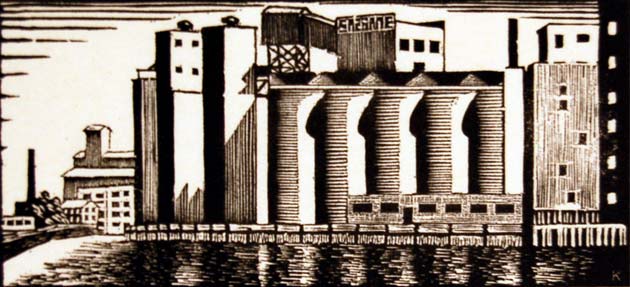Kevin O'Callahan: Buffalo Rivier
by Dean Brownrout

Kevin O’Callahan (1902-1977) was the founder of the Buffalo Print Club, and a master printmaker in his own right. The Buffalo Print Club’s heyday was in the 1930 and 1940s.
Printmaking came into favor during the Great Depression, when organizations like the Buffalo Print Club were formed across the country. They both sustained significant artistic and social communities and created a democratic and affordable way for the general public to acquire artwork.
The quality of work that was generated by O’Callahan and the club was exceptional. At first the group created mostly pastoral Western New York landscapes and bucolic scenes. But O’Callahan saw the beauty in the area’s industrial architecture.
O’Callahan created a set of depictions of these industrial settings that are the most sought-after of his pieces today. These works are among the finest visual and historical representations asserting the importance of these landmarks to our region.
O’Callahan’s work is represented in the Library of Congress Collection of American Prints. His prints are not simply a historical record of these places. They show the magnificence that O’Callahan and many other artists who worked in this region perceived.
Artists like James Vullo, Arthur Lindberg, Anthony Sisti, Ralston Crawford, and Charles Burchfield also incorporated these structures into their work—whether for social commentary or simply admiration of their majesty.
It is in this art that we can find much to guide us in imagining our region’s future. Lynda Schneekloth, professor at UB School of Planning and Architecture and author of Reconsidering Concrete Atlantis: Buffalo Grain Elevators, is among those working today to focus public attention on the positive future our area could have with adaptive reuse of these industrial monuments.
Schneekloth—and many other architects and urban planners—do not see these structures as decaying relics of a bygone age. In fact, they assert that our entire body of waterfront factories and grain elevators should be designated on the National Register of Historic Places, and in addition, that repurposing these sites can and should be an important component of our region’s economic and social rebirth.
It is important for O’Callahan’s industrial work to be viewed by this generation in that light. Seeing the value and beauty of our industrial monuments, as O’Callahan did, might inspire those with the power to effect change to do so.
blog comments powered by Disqus
|
Issue Navigation> Issue Index > v7n39: The Sphere (9/25/08) > Kevin O'Callahan: Buffalo Rivier This Week's Issue • Artvoice Daily • Artvoice TV • Events Calendar • Classifieds |









 Current Issue
Current Issue